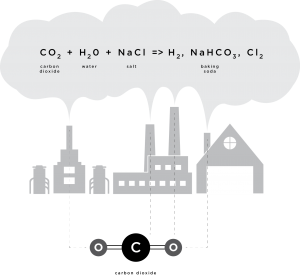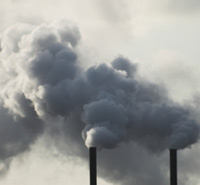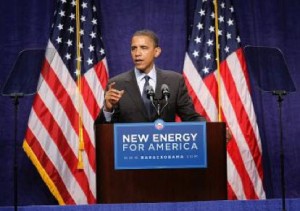Climate Change
New Report Tells Us What We Already Know: The Green Movement is Too White
 There's an old joke that the best place to find black or brown people in the environmental movement is in grant proposals. Every group uses the well-known and terrible demographic facts of environmental justice to justify their own programming, but almost none of that programming directly involves the subject of those terrible demographics.
There's an old joke that the best place to find black or brown people in the environmental movement is in grant proposals. Every group uses the well-known and terrible demographic facts of environmental justice to justify their own programming, but almost none of that programming directly involves the subject of those terrible demographics.
It didn't get much press, but a new University of Michigan study of a broad array of organizations doing environmental work showed that while black and brown citizens represent nearly 40 percent of Americans, they account for fewer than 16 percent of the employees in those organizations – and that's counting state and federal agencies. Private groups and foundations fare even worse – only 12% of their numbers are people of color. On any given day, the Ferguson Missouri police department and your local environmental group look about the same.
According to the study's author, Dorceta Taylor, a professor in the School of Natural Resources and Environment at the University of Michigan "an 'unconscious bias' exists within the liberal and progressive culture of the groups, preserving a racially homogenous workplace. Recruitment for new staff frequently occurs through word-of-mouth and informal networks. This makes it difficult for ethnic minorities, the working class, or anyone outside of traditional environmental networks to find out about job openings and apply for those jobs.”
In its coverage, the Washington Post, says the report shows the existence of "…two environmental movements. One is white and the other non-white, one rich and the other poor, one devoted largely to advocating on behalf of wilderness areas and the other for “environmental justice” in core urban areas where minorities tend to live." That divide is far more prevalent among the larger, well financed groups that can afford to even hire staff than it is at the grassroots level where all groups struggle and there's less emphasis on wilderness issues. Nevertheless, the divide is there and it's making environmentalism a political side show instead of a a major stage event.
Most of the time, people are motivated by self-interest. When a huge and growing segment of the country's population doesn't see a self-interest in having safe water and air or open spaces, these things become less and less important to a national agenda. And yet, those demographic facts don't lie. Black and brown asthma rates are far above whites. Most polluting industries locate in places that can't fight back. Just as there's a huge imbalance at the top in terms of leadership, so there's also a huge imbalance of who's at risk on the bottom rungs. People of color ignore the environmental agenda at their own risk. But environmental groups that ignore people of color do so at their own risk as well. In another generation, they'll be as relevant as Civil War re-enactors.
We all have to do a better job of connecting the dots, Downwinders included. Right now, we have exactly one person of color on our board and none on staff. Good intentions matter, but they don't matter enough to be used as excuses. Those of us doing the front line work must find the time to widen our ranks or we'll find ourselves without ranks at all.
Study: Climate Change Will Likely Increase DFW Smog
 Just last week at the June regional air quality planning meeting the Texas Commission on Environmental Quality was bemoaning the fact that the weather too often determines how bad an "ozone season" DFW will have. And it's true. When we have really hot, dry, and windless summers, ozone levels soar as they did as recently as 2011-2012 when the recent drought seemed to reach its most awful heights in DFW. Conversely, when we have relatively cool, wet and windy summers, ozone levels abate, as they seem to be doing this year – at least so far.
Just last week at the June regional air quality planning meeting the Texas Commission on Environmental Quality was bemoaning the fact that the weather too often determines how bad an "ozone season" DFW will have. And it's true. When we have really hot, dry, and windless summers, ozone levels soar as they did as recently as 2011-2012 when the recent drought seemed to reach its most awful heights in DFW. Conversely, when we have relatively cool, wet and windy summers, ozone levels abate, as they seem to be doing this year – at least so far.
Of course, the TCEQ spokesperson was using weather as an excuse why DFW hadn't yet achieved compliance with the 1997 ozone standard after two tries that fell short. Completely overlooked was the fact that the last state air plan for DFW in 2011 promised historically low ozone levels by 2013 without any new pollution controls on major sources of pollution. Combine that lack of action with a really hot, dry summer like we saw in 2011, and you get the first clean air plan ever to leave ozone levels higher after it ended than when it started.
That's why it's important to think about the weather when you're trying to build new clean air plans for DFW that stretch years into the future. Air quality planners have to ask themselves if between now and the next federal clean air plan deadline of 2018, will there be more summers like this seemingly anomalous one, or will they more like the summer of 2011 when we had a constant barrage of 100 degree plus days as early as March?
Currently, the TCEQ is using a stretch of bad air days from 2006 to predict ozone levels between now and 2018 in their computer model for the DFW air plan to comply with the new, tougher 2008 ozone standard. But 2006 was pre-drought. Although they say they're "adjusting" the meteorology to compensate for weather changes since then, do you really trust TCEQ to assume worst-case weather scenarios when they're still trying to hide the smog impacts of gas pollution from the public? Us either.
So it's with more than a little self-interest that we note a new Stanford study with the too-sexy title of "Occurrence and Persistence of Future Atmospheric Stagnation Events" concluding that the Western US, including Texas, should expect hotter and therefore smoggier summers thanks to climate change. Why? Because hotter temperatures will slow the flow of air around the globe. That means less wind, and less wind means more time for smog-forming chemicals to sit and bake in the hot sun and form harmful levels of ozone. Historically, most of our worst ozone days are when winds are blowing less than 5 mph – stagnate air.
DFW isn't like Denver or LA where mountains form bowls around the urban areas and trap pollution in inversions. But the new study concludes the impact from global warming could have the same effect on the Texas prairie by stagnating air currents:
"Our analysis projects increases in stagnation occurrence that cover 55% of the current global population, with areas of increase affecting ten times more people than areas of decrease. By the late twenty-first century, robust increases of up to 40 days per year are projected throughout the majority of the tropics and subtropics, as well as within isolated mid-latitude regions. Potential impacts over India, Mexico and the western US are particularly acute owing to the intersection of large populations and increases in the persistence of stagnation events, including those of extreme duration. These results indicate that anthropogenic climate change is likely to alter the level of pollutant management required to meet future air quality targets."
And who's more prepared to deal with the "pollution management required to meet future (re: tougher) air quality targets than the Texas Commission on Environmental Quality? Almost any one, including your 13-year old niece who's done so well in 8th grade science this year. Because not only is it the TCEQ's official position that smog isn't all that bad for you, but that there's really no such thing as climate change. It's why you should bring a boatload of skepticism to the computer model that's driving the currently proposed DFW clean air plan. To plug hotter and hotter temps into the DFW smog model for coming years would be admitting to a phenomena that the Rick Perry administration in Austin just can't bring itself to concede. One more example of how the DFW plan is being driven by politics, not science.
As the TCEQ's own staff admitted last week, DFW's ozone levels are often hostage to the weather. If you're model isn't correctly estimating the weather during future ozone seasons, chances are your estimates of future ozone levels will be off as well. But of course, since smog isn't really bad for you there's no downside to being wrong about these things at TCEQ HQ, and only an upside in GOP primaries.
For the rest of us who believe what the science tells us, the consequences are more dire. As the VICE magazine take on the Stanford study said:
"….one reason this study is so important to the climate change conversation—it underlines the public health threat posed by climbing temps. When Obama was touting the EPA's new carbon regulations, he emphasized the public health benefits of drawing down emissions: It would reduce asthma and respiratory illness, he pointed out. But that's largely because shuttering dirty power plants cuts both carbon and particulate pollutants simultaneously; fighting climate change also means fighting asthma.
Now, scientists have demonstrated there's an additional layer of concern to grapple with on the pollution front; climate change is going to begin blocking cities' toxic release valves. If we don't work to slow carbon emissions, these steamier cities will find their streets clogged with stagnant smog. Scrubbing that pollution and finding novel ways to clear the air, too, then, will prove to be a pressing concern in the not-so-distant future.
Show Me the Money: Putting a Dollar Value on Climate Change
 How do you monetize a human life? How about when that life is impaired with an illness? What's it worth to you not having to rush your child to the emergency room when they're turning blue during an asthma attack? What about to prevent a heart attack?
How do you monetize a human life? How about when that life is impaired with an illness? What's it worth to you not having to rush your child to the emergency room when they're turning blue during an asthma attack? What about to prevent a heart attack?
These days we live in a cost-benefit world that demands this kind of accounting for things that should be accepted at face value. Want to talk about the advantages of cleaner air? You have to be able to put a price tag on it. And, with a small slight of hand, that's what the Obama administration did when it touted all the economic reasons why its new carbon capture rule for existing power plants was a plus for the country.
Carbon pollution itself doesn't directly cause the kind of death and suffering among humans that the Clean Air Act was written to address. Oh sure, it might doom countless species, raise sea levels, and cause global catastrophe, but there's not a way to tie it directly to more mundane respiratory diseases or early mortality that we (well, everyone but the Texas Commission on Environmental Quality) associate with "air pollution."
Instead of pricing catastrophic planetary effects, no matter how self-evident their true costs might be, the EPA instead sought out to tag the out of pocket expenses saved by Americans in cutting pollution associated with carbon, like Particulate Matter and smog. Most of the $55 to $93 billion in economic gains cited by the EPA last week came from these co-benefits, rather than from added spending and jobs in renewable energy or preventing massive crop failures. Otherwise, the new rules might not have been "worth it" from a regulatory point of view. The administration projects the new rules will cause the loss of between 79,900 and 80,400 full-time equivalent jobs in power generation versus 111,800 full-time equivalent jobs in renewable or energy efficiency work, basically a wash.
Want to know the price of an asthma attack? $58. Multiply that by 140,000 to 150,000 across the country and you have the approximately $9 million saved over the next 15 years by reducing soot and smog – a side effect of reducing carbon pollution under the rules.
Non-fatal heart attacks cost an average of $98,000 in health care costs and lost earning power among under-25-year-olds versus an average of $200,000 among 55- to 64-year-olds, because this later demographic is supposedly reaching its peak earning power. Preventing a six-day bronchitis episode is valued at $430.
By far the largest single health impact from the carbon rules seems to come from the forecasted reduction in deaths associated with PM pollution, quickly becoming the most insidious and widespread air pollution threat in the world, and smog. EPA economists estimated savings of between $27.3 billion and $66.7 billion from lower levels of PM 2.5 (fine particles smaller than 2.5 microns in size) and Nitrogen Oxide by preventing 2,700 and 6,600 early deaths.
Most of these numbers come from anticipated cleaner or closed coal plants. It's not unusual for EPA to do accounting this way for the rules it's proposing, although it's the first time it's used it to justify carbon pollution regs.
Will these kinds of arguments win over the skeptics? Doubtful, but that's not who they're aimed at. Instead the administration is using these numbers as talking points to the media and the public in hopes of creating momentum the skeptics can't reverse or rationalize. After all, it's hard for even Rick Perry to call out your child's asthma attacks as unimportant or inconsequential.
Big Green Discovers It Needs More Than A DC Office to Win
 In 2010, there was a very large and coordinated push by the nation's largest environmental groups and President Obama to get climate change legislation through Congress. Even with a "Democratically-controlled Congress" it failed.
In 2010, there was a very large and coordinated push by the nation's largest environmental groups and President Obama to get climate change legislation through Congress. Even with a "Democratically-controlled Congress" it failed.
Four years later, the president has ditched Congress and is resorting to his executive authority under the Clean Air Act to initiate a cap and trade system for CO2 that reportedly will demand a 30% drop in emissions from 2005 levels from the country's existing power plants. There are lots of potential land mines in this approach – if it can survive the gauntlet of legal challenges form industry. And if it does?
"It's going to be like eating spaghetti with a spoon. It can be done, but it's going to be messy and slow," said Michael Gerrard, director of the Center for Climate Change Law at Columbia University.
As for Big Green, it's discovered that DC lobbyists and think tank policy analysts do not a movement make. Prompted by their own failure, a soul-searching New Yorker article in 2013 questioning the wisdom of a corporate-like top down approach, as well as new groups that were filling the vacuum of leadership – like the more radical and highly decentralized Keystone campaigns, a change in perspective begin to occur.
“The national environmental groups said, ‘We need to do more in-your-face activism,’ ” said Gene Karpinski, the president of the League of Conservation Voters. “You can’t just lobby members of Congress with a poll that says people support you.”
As a result the big groups have re-tooled to catch-up. They're now sponsoring more direct actions, including divestment campaigns at universities, and public protests, as well as spending big bucks in targeted state elections. They're decamping from the Capitol and spreading out their resources. In doing so, they're building new organizing models for themselves, models that take cue from smaller, more dynamic, more effective grassroots groups. It's a change for the better.
Human-Induced Earthquakes and Cooking the Planet: We’re Living the Next Hollywood Sci-Fi Blockbuster
 "Environmentalism" as a cause in America has its roots in the wilderness, the "otherness" a person can discover when he or she is separated from their own kind and put among crowds of the planet's non-human inhabitants. Walden Pond. National Parks. These were all meant to be meditative retreats from "civilization," from which you could escape. Environmentalism was a revelatory and individualistic experience.
"Environmentalism" as a cause in America has its roots in the wilderness, the "otherness" a person can discover when he or she is separated from their own kind and put among crowds of the planet's non-human inhabitants. Walden Pond. National Parks. These were all meant to be meditative retreats from "civilization," from which you could escape. Environmentalism was a revelatory and individualistic experience.
Then came the understanding of environmentalism as a way to affect collective public health. Air pollution we breathe into our bodies causes lung cancer and asthma. Swallowing water with toxins in it when you're pregnant can cause birth defects. Eating foods with pesticides in them can affect a child's hormones. Still, the impacts were mostly seen person by person, and they depended on lots of variables – genetics, location, exposure. Not in my backyard.
Now however we're in a whole new age of cause and effect. The scale is planetary. The sky we live under as well as the ground we walk on.
Imagine Hollywood makes a movie about alien invaders who want to reshape the Earth for their own purpose, say like "Battleship." They begin pumping in massive quantities of CO2 and methane, driving up the temperature way beyond anything in recent history and setting-off all kinds of chain reactions among species and weather conditions. They begin extracting minerals by poking deep holes in the earth and then setting off large explosions, the waste of which causes not-insignificant earthquake activity when they pump it back into the ground under tremendous pressure. Their huge spaceships sometimes leak radioactivity, and if they just happen to be sitting beside oceans that can be used as industrial-size septic tanks, all the better.
That's what it feels like now, in 2014.
In case you missed it, the United States Geologic Service issued its very first "Earthquake warning" for Oklahoma:
"A new study found that earthquakes in Oklahoma rose by 50 per cent over the last seven months, leading researchers to warn that the risk of a damaging earthquake measuring a magnitude of more than 5.5 has increased significantly in the state. Agencies reported 183 earthquakes of magnitude 3.0 or higher from October until April 14th, compared with an average of only two per year from 1978 to 2008."
Usually reserved for places like California or Alaska to warn residents of the risk of damaging aftershocks, this is the first time the USGS has issued an earthquake warning for a state east of the Rockies. In the Sooner State, the aftershocks are thought to be caused by fracking waste injection wells. A Cornell University study released this week showed a link between waste wells and earthquakes up to 50 kilometers away.
"A new study of the Jones earthquake swarm, occurring near Oklahoma City since 2008, demonstrates that a small cluster of high-volume injection wells triggered earthquakes tens of kilometers away. Both increasing pore pressure and the number of earthquakes were observed migrating away from the injection wells.
"The existing criteria for an induced earthquake do not allow earthquakes associated with the well activity to occur this far away from the wellbore," said Katie Keranen, assistant professor of geophysics at Cornell University, who led the study of the Jones earthquake swarm. "Our results, using seismology and hydrogeology, show a strong link between a small number of wells and earthquakes migrating up to 50 kilometers away" said Keranen. "
Moreover, we're just beginning to understand the threat to infrastructure from human-induced earthquakes…
"Last week scientists attending the Seismological Society of America annual meeting in Anchorage, Alaska called for more research into the relationship between fracking wastewater disposal and earthquake activity.
Gail Atkinson, an earth sciences professor at the University of Western Ontario, presented research at the conference highlighting the “significant and as-yet-unquantified risk” to the integrity of critical infrastructure, such as major dams and nuclear power plants posed by induced seismicity.
Part of the problem is that fault lines in the areas most affected by fracking operations are often poorly and incompletely mapped. Texas, Ohio, Colorado and Oklahoma, which have in recent years experienced unprecedented seismic activity, have never been made a priority like California and other states where quakes have long been a threat."
SMU and USGS scientists looking into the Azle earthquake swarm were also at this same Alaska conference presenting their paper showing the vast majority of recent earthquakes near that city were centered between two injection wells, including a large XTO one. Expect to see some follow-up as reporters and citizens take their first look. And while we really do expect an alien invasion to occur before the State of Texas voluntarily does anything to stop the problem in Azle, there's a House Energy Committee, Seismic Activity Sub-Committee hearing next Monday May 12th, where only invited testimony will be heard. Sharon has the details for folks that want to make another trip to Austin.
Meanwhile, April saw new highs in atmospheric poisoning.…
The end of April has arrived, and with it, the record for the first month in human history with an average carbon dioxide level in Earth’s atmosphere above 400 parts per million has been set.
With a little more than 24 hours left in the month, the average for April can't slip below 400 ppm. “Every day in April has been over 400 ppm,” said Pieter Tans, a climate scientist with the National Oceanic and Atmospheric Administration.
The levels of carbon dioxide in the atmosphere are monitored from a site atop Hawaii’s Mauna Loa volcano, where they have been measured continuously since 1958. The long record has charted the steep rise of the greenhouse gas — the most prevalent in Earth’s atmosphere — as a result of human emissions.
The first measurement in excess of 400 ppm was made on May 9, 2013. This year, the level rose above that mark a full two months earlier, and has remained above 400 ppm steadily since the beginning of April.
And lest you think you'll be long gone before the effects of this change affect you and yours, yesterday's new National Climate Assessment report wants you to know that,
"The effects of human-induced climate change are being felt in every corner of the United States, scientists reported Tuesday, with water growing scarcer in dry regions, torrential rains increasing in wet regions, heat waves becoming more common and more severe, wildfires growing worse, and forests dying under assault from heat-loving insects.
Such sweeping changes have been caused by an average warming of less than 2 degrees Fahrenheit over most land areas of the country in the past century, the scientists found. If greenhouse gases like carbon dioxide and methane continue to escalate at a rapid pace, they said, the warming could conceivably exceed 10 degrees by the end of this century.
“Climate change, once considered an issue for a distant future, has moved firmly into the present,” the scientists declared in a major new report assessing the situation in the United States."
Conscience-ridden scientists making dire warnings about the threat. A government too slow or self-interested to act to thwart the threat. We know this movie. From the POV of the moving camera, we see the same forces of darkness making things go boom underneath us are also filling up our thin layer of atmosphere with gunk. This is no longer something we can escape from, nor is it a matter of local public health. After years of hearing that the sky is falling, now it really is. Only instead of aliens causing it, it's us treating the planet as if we were.
In such a Hollywood Blockbuster, the heroes would be the scrappy, common-sense fueled citizenry who had managed to outrun and outsmart the aliens in various small and large ways while governments fumbled and greedy privateers made deals with the newcomers. With some imagination, a rag tag group of locals fighting a single alien ship out in the boondocks would finally find an out-of-the-box way to disrupt, confuse, and eventually defeat the enemy. As the credits begin to roll, you can see word of this grassroots strategy spread across the globe and its effectiveness showing up in Paris, Moscow, Nairobi, Mexico City, and Hong Kong.
This is that movie. We're in it. Are you a member of the scrappy resistance or an anonymous uncredited crowd extra? Quick, the tide's coming in.….
Another Chapter of “Why Don’t We See This in Midlothian?”
 Cement plants are among the world's largest sources of CO2. In order to reduce their carbon footprints, either voluntarily or to comply with new environmental regulations, as well as make a buck, owners are trying out different strategies to turn their Greenhouse Gases into just plain green cash.
Cement plants are among the world's largest sources of CO2. In order to reduce their carbon footprints, either voluntarily or to comply with new environmental regulations, as well as make a buck, owners are trying out different strategies to turn their Greenhouse Gases into just plain green cash.
As far as we can tell, the "SkyMine" pilot-project announced for San Antonio's Capital Aggregates Cement Plant is still on schedule for operation later this year. Employing 50 people, the first-of-its-kind facility will convert the cement plant's carbon dioxide into baking soda and hydrochloric acid that's aimed at oil and gas field use.
Now comes word that a LaFarge Cement Plant in Canada is hooking up with a fuel cell company to make a slightly more progressive product from its GHGs:
"Mantra Energy Alternatives has struck a deal with Lafarge Canada to deploy an electrochemical reduction technology at Lafarge’s No. 9 Road cement plant.
“This will be the first pilot plant of its kind in the world,” said Mantra’s vice-president Patrick Dodd in a press release.
On paper, the technology would convert carbon dioxide, considered the most prolific greenhouse gas, into useful chemicals like formic acid and formate salts. The pilot plant would convert 100 kilograms per day of carbon dioxide emitted from the local cement plant into concentrated formate salts, which sell for about $1,500 per tonne.
Mantra is eying the formic acid for use in its patented fuel cells, which it bills as a significantly less expensive fuel cell with greater power density."
Granted, the manufacturing of oil and gas chemicals sounds more likely for one of the three huge Midlothian cement plants to attempt than diving into the alternative energy business, but at least it's something. The end products can change and adapt but these projects begin to put the infrastructure of a supply and demand system in place while seeing potentially large decreases in CO2 output. In 2014 America, the fastest way to get reductions in GHGs is to make it profitable to do so. These experiments pave the way for that to happen.
There's no question that the TX/ Martin-Marietta, Holcim and Ash Grove cement plants are the largest stationary sources of CO2 in North Texas, or that together, they form a huge GHG hotspot. All the old coal-fired power plants that would have challenged them have been shuddered or converted to gas.
While (forced) modernization at all three plants like the conversion from wet to dry kiln technology has brought all emission totals down, particularly CO2, the fact remains that the huge scale of operations in Midlothian means there's no other facilities that churn it out as much. And yet not one creative idea for how to reduce those huge local emissions has been announced from any of those companies. You can't just use the Texas excuse because the San Antonio experiment is happening despite no immediate government mandate, especially on existing facilities. And you might think that the first company to do so would receive some needed good PR. But nope.
This has been another chapter of "Why Don't We See This in Midlothian?"
Can You Hear Me Now? EPA’s National “Listening Session” on New Coal Carbon Pollution Rules This Thursday
 Many of you have already seen the increasingly urgent pleas from the usual suspects for people to show up at this Thursday's national EPA "Listening Session" on new emission standards for Greenhouse Gas pollution. Try to ignore the New Age-by-way-of-George-Orwell alternative name for a public hearing, and the industry-friendly "listening" schedule of 10 am to 3 pm, and concentrate on the fact this is one of only a handful of such sessions taking place nationwide, and it's in Texas, our Texas.
Many of you have already seen the increasingly urgent pleas from the usual suspects for people to show up at this Thursday's national EPA "Listening Session" on new emission standards for Greenhouse Gas pollution. Try to ignore the New Age-by-way-of-George-Orwell alternative name for a public hearing, and the industry-friendly "listening" schedule of 10 am to 3 pm, and concentrate on the fact this is one of only a handful of such sessions taking place nationwide, and it's in Texas, our Texas.
Like it or not, public health-minded residents of DFW have the burden of showing up to national hearings like this just to prove we exist. Nobody expects there to be an viable environmental movement in the Belly of the Beast, especially outside Austin. However hard we work to change that image, it's still a popular one and in this case, it hits entirely too close to home. Because Texas is the world capitol for carbon pollution. We're Numero Uno, A Number 1. We're living in the barrel of the gun that's pointed right at the planet's head.
EPA recently reported that Texas released more GHG pollution in 2012 than the next two states – Indiana and Pennsylvania – combined. We're responsible for a full 12.5 % of the entire US annual total, almost 400 million metric tons of the stuff, ever year. Just take a look at the difference between us and the other 49.
Then use this handy-dandy EPA map of incredibly large sources of GHG pollution in the US. It allows you to zoom down to what's in each county of each state. Look at all the sources around DFW. Most are also large sources of other kinds of pollution. We're living in a sea of pollution created by these facilities.
So when EPA decides to schedule its one and only listening session in Texas on new rules to reduce this kind of pollution from some of the biggest sources in our own backyard, we need to show up because we're a disproportionate part of the problem.
We also need to be there because industry will be there, in force. The old TXU really wants to keep its obsolete, lignite-burning East and Central Texas coal plants running without any of these modern pollution control contraptions. Doesn't matter if they're aimed at Particulate Matter, or smog-forming pollution or GHGs, they just don't want them. You can bet they'll be bringing in folks from those coal plants to say what a terrible economic cost it would impose on the host communities and the company, and how it'll put the entire statewide grid in peril.
Someone has to be there to balance that testimony by pointing out that the economic, public health, and environmental impacts of this pollution reach far beyond Limestone County, Texas or even the US, and need to be considered on the agency's balance sheet as well.
Every yahoo with Americans for Prosperity, or other industry astroturf groups will be there because these kinds of national forums to bash Obama's energy policies are what they live for – and it's the only thin they do halfway competently. Likewise for the industry-aligned Freedom Works branch of the Tea Party.
And does someone want to start an office pool on how many Republican primary candidates will be appearing, trying to outflank each other on their Right? Expect to see and hear a lot about "Obama's War Against Coal" on Thursday. It's Texas.
Which is why even if you're not a fan of this Administration, you have to recognize that the first attempt to regulate greenhouse gases from coal plants should be encouraged, in Texas. It's a foot in the door to do more effective things, to start talking about GHG regulations in a serious way. It establishes a precedent. And that is what industry fears the most. You don't have to like the EPA to understand that the enemy of your enemy is your friend in this fight. And did we mention it's in Texas?
Finally, we just emerged from an ozone season that was mild by recent standards – but still harsh enough to keep us in violation of the old 1997 smog standard. We know the East and Central Texas power plants contribute to DFW's air quality problems. These new carbon regulations EPA is considering for existing power plants have the potential to reduce a variety of air pollution, not just GHGs. We know Austin and TCEQ are going to be of no help in addressing these sources in the next DFW clean air plan. If reductions are going to happen, they're going to have to be driven by the EPA, local governments, or the marketplace. We can't let this opportunity for meaningful reductions and better air pass us by. If for no other reason, you need to show up on Thursday and say you support the EPA's regulation of these facilities because you've given up on Texas doing so.
For lots of reason, it's in your own self interest to attend this thing, even if you real passion is gas field pollution, or smog, or cement plants or whatever. A victory in this category of regulation is a victory for all of us involved in clean air issues. And it's Texas.
National EPA "listening session" on carbon limits for existing coal plants
THIS Thursday, November 7, 10:00 a.m. to 3:00 p.m.
1st Floor Auditorium, J. Erik Jonsson Dallas Central Library, 1515 Young Street, Dallas, TX (map)
Your Tax Dollars at Work: TCEQ Argues Air IS NOT a Natural Resource
 So this is how ideological things have become at the Texas Commission for Environmental Quality. Even though the agency won a fight in court to keep a group of parents represented by the Texas Environmental Law Center from being able to sue the state for not regulating Greenhouse Gases, TCEQ lawyers are working overtime to make the judge in the case retract this statement:
So this is how ideological things have become at the Texas Commission for Environmental Quality. Even though the agency won a fight in court to keep a group of parents represented by the Texas Environmental Law Center from being able to sue the state for not regulating Greenhouse Gases, TCEQ lawyers are working overtime to make the judge in the case retract this statement:
“The Court will find that the Commission’s conclusion, that the public trust doctrine is exclusively limited to the conservation of water, is legally invalid. The doctrine includes all natural resources of the State."
To the untrained eye, this might seem a pretty innocuous piece of prose. Water, air, land, these are pretty much the very definition of "natural resources." But them are fightin' words to Rick Perry's environmental watchdogs. Concede this point to the hippies, and there's a slippery slope leading all the way down to effective regulation and supervision of airborne threats to the public health. Unacceptable.
You see under state law, only water is legally treated as a natural resource in Texas, subject to what's called the "public trust doctrine," which requires government to protect and maintain certain shared resources fundamental for human existence.
TCEQ lawyers are saying air just isn't so fundamental to humans as the wet stuff, although the last time we checked, most people could only last 2 to 5 minutes without it.
State lawyers late last month argued in front of the Texas Third Court of Appeals that Judge Triana’s comments were beyond the scope of the case and should be vacated.
Terry Clawson, an agency spokesman, said….“The T.C.E.Q. has concerns with how the district court opinion addressed the matter of public trust doctrine,” Mr. Clawson added. “The scope of this doctrine is a very important issue, which deserves to be fully vetted.”
The agency complained to the court that Judge Triana’s statements were seen by the plaintiffs “as a victory,” even noting that environmental groups had called her ruling “a blockbuster” for their cause in news releases.
But David Spence, a professor of business and law at the University of Texas at Austin, said the scope of public trust was more symbolic than practical.
“In a sense it’s a kind of low-stakes argument,” Mr. Spence said. “The public trust doctrine in the U.S. is a fairly weak thing.”
Each state applies the principle differently, and few have used it with much force. The doctrine has generally been successful only at protecting open beaches for public use, Mr. Spence said.
So which is it – practical or symbolic? For both citizens and the TCEQ, the two are one in the same. Rick Perry's appointees cannot afford to let citizens get their foot in the legal door to establish a principle that may result in one day overriding their own authority, however abstract it appears that threat is now.
Likewise, in a state government as hostile to citizen concerns as this one, what do you have to lose in trying to establish a, er, beachhead, in terms of seeing safe and legal air as a finite "natural resource" that should be protected? Indeed, one of TCEQ's predecessor's names was the Texas Natural Resources Conservation Commission. It regulated air pollution in Texas – presumably because it was a Natural Resource. This "Hail Mary!" legal strategy seems at least as effective as going down to Austin every two years expecting things to get better.
The appeals court is expected to rule soon. It could remove the statement entirely from the record the way TCEQ wants, or merely say is a statement and not a legal precedent, which is what even the plaintiff's lawyers expect. Stay tuned.
EPA will Be Issuing Power Plant Permits in Texas Despite Greg Abbott’s Campaign for Governor
 There was never really any question, but just in case you were wondering, EPA will indeed be taking over the permitting of power plants in Texas based on new greenhouse gas emission rules.
There was never really any question, but just in case you were wondering, EPA will indeed be taking over the permitting of power plants in Texas based on new greenhouse gas emission rules.
The U.S. Court of Appeals slapped down Texas Attorney General Greg Abbott's recent challenge to the Environmental Protection Agency on Friday, one trying to keep the EPA from considering such emissions when they permit new facilities or approve large modifications on old ones.
Obama’s Speech Fracked Open
 The San Fransicso Chronicle has a take on how the Obama climate change speech jives with the reality in the country's Shale Gas fields – like the one you live in.
The San Fransicso Chronicle has a take on how the Obama climate change speech jives with the reality in the country's Shale Gas fields – like the one you live in.
Robert Howarth, a Cornell University professor who argues that methane leaks from drilling negate other climate benefits of gas, said in an email to The Associated Press that he is "extremely disappointed in the President's position" and said the support for natural gas "is very likely to do more to aggravate global change than to help solve it."
Not so, Obama said.
Advances in drilling, the president said, have "helped drive our carbon pollution to its lowest levels in nearly 20 years," and "we'll keep working with the industry to make drilling safer and cleaner, to make sure that we're not seeing methane emissions."
